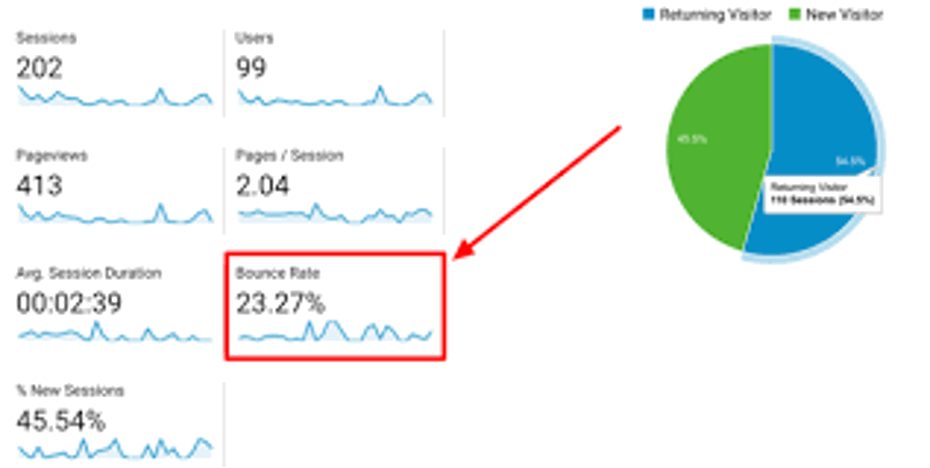Are you wanting to know Why does your website have Such a High Bounce Rate? It can be an overwhelming feeling when you don’t understand why your website isn’t performing as expected and it’s important to know what’s causing it. Fortunately, there are some common explanations for why your website’s bounce rate might be so high, and this article will provide insight into the reasons why and offer strategies to help improve it.
What is Bounce Rate?
Bounce rate is the percentage of visitors to your website who leave after viewing a single page. It is an important digital marketing metric that tells you how quickly users are leaving your website. Knowing your website’s bounce rate helps you to measure the overall performance of your website, and allows you to make improvements to attract and retain more visitors.
Common Reasons for High Bounce Rate
- Poor Quality Content: Content is the most important element of your website and if the content is not up to par, it is likely that visitors will be quick to leave your website. Poor quality content can be unclear, boring, or full of errors and it is likely to leave visitors feeling frustrated.
- Poor Site Design: The design of your website also plays an important role in visitors bouncing quickly. If your site is difficult to navigate, visitors can become easily lost or confused and will likely leave your website.
- Slow Website Load Times: In today’s day and age, people are used to sites loading quickly and if yours takes too long, visitors are likely to become frustrated and leave before they even get to see what you have to offer.
- Inaccurate Page Titles and Descriptions: Page titles and descriptions that don’t accurately describe the content on a page can cause visitors to click away thinking it’s not what they are looking for. This can also create a poor user experience, resulting in visitors leaving quickly.
- Unattractive Images: Images are an important element to your website and can often be the first thing a user notices when entering your site. If the images are not up to par, visitors may be discouraged from staying, resulting in a high bounce rate.
- Unclear Value Proposition: If your website’s value proposition is unclear or not easy to understand, visitors are likely to leave quickly as they will not know what they can expect or gain from being on your website.
Strategies to Improve Bounce Rate
- Create Quality Content: Quality content is essential in attracting organic traffic as well as keeping visitors on your website longer. Create content that is informative, engaging, and up-to-date to help reduce your website’s bounce rate.
- Improve Your Site Design: Make sure your website is easy to navigate, with clear menus and effective search features. A clean design also goes a long way in creating a positive user experience and reducing bounce rate.
- Optimize Your Images: Pictures are worth a thousand words and can help give visitors a first impression of your website. Make sure your images are of good quality and relevant to the content on that page.
- Write Good Meta Descriptions: Meta descriptions provide a brief summary of the content and should include keywords relevant to the page. Good meta descriptions increase the chances of your website being found in search engine results, which can help reduce bounce rate.
How Can On-Page SEO Generate Traffic?
Lets talk about How Can On-Page SEO Generate Traffic.
- Optimizing Title Tags: Title tags are HTML elements that tell search engine crawlers and users what the page is about. Optimizing them effectively can help optimize your website for search engine results, increasing the chances of people finding your website and reducing your bounce rate. Utilizing Heading Tags: Heading tags or H tags help to break up the text on a page into sections which improves the readability of the content. This helps make sure your content is easy to digest and follow, which can reduce bounce rate.
- Optimizing Internal Link Structure: Internal links are important for not only improving the user experience but also for helping to optimize your website for search engines. Having an effective internal link structure helps make sure users can easily get to the content they are looking for and can also aid in reducing bounce rate.
- Crafting Meta Descriptions: Crafting effective meta descriptions with relevant keywords can help your website be seen in search engine results easily and can increase the chances of visitors staying on your website for longer.
- Structuring Content Strategically: Content structure should be strategic with an effective flow that allows visitors to engage with the content. Make sure the content is easy to understand and breaks up long sections with headings to make it easier to read.
- Improving Page Load Times: It is important to make sure your pages load quickly or visitors may become frustrated and quickly leave your website. Once your website loads fast, visitors are more likely to stay and explore your website, resulting in a lower bounce rate.
Conclusion
A high bounce rate can be discouraging, but it doesn’t have to be. Following the strategies outlined above can help you identify the source of your high bounce rate and provide effective solutions to reducing it. Implementing these strategies can help your website achieve long-term success and keep visitors engaged and coming back for more. For more information click here.





























